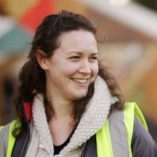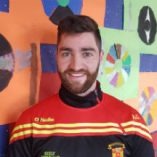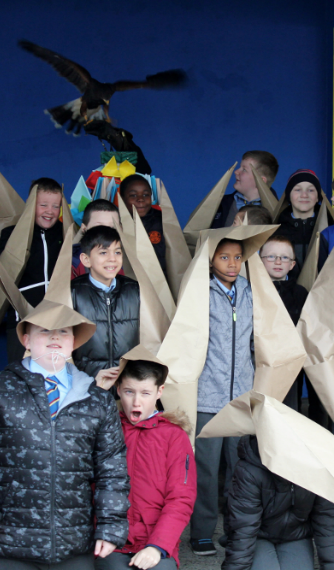Refine by Region
Refine by Art Form
Refine by School Level
Creative Generations – O’Connell CBS P.S. with artist Maria McKinney
Tell us the story of your project – What was the impetus? What was it about? Who was involved? How did you begin?
Jean Mann, Creative Generations Education Curator
We were looking for a primary school in the area local to programme sponsors Central Bank of Ireland and were delighted to find O’Connell School. It is a really interesting school with a rich history, and a very supportive learning environment, which was fantastic to work with. Artist Maria McKinney was a natural choice for working on this project. Her practice is often focused around ecology and I thought this would be a good fit for the primary school age range. Maria brought with her a wealth of experience in working collaboratively with diverse fields of inquiry and a sensibility to materials which made her very suitable for this residency.
Maria McKinney, Artist
I was aware of the Temple Bar Gallery & Studios education programme from seeing some of the previous projects on social media and speaking to the artists that took part. I was very happy when Jean then approached me to do their autumn 2017 session in O’Connell School. I had only recently moved into my studio in Temple Bar and was excited to be involved in their programme so early on.
One of the first things I was told about O’Connell School, in addition to it being a boys’ primary school, was that is was directly below Croke Park. The seating of the stadium almost hangs right over the school. This in itself made it very unique. Then I remembered seeing a news article about birds of prey that are put to work in Croke Park to keep away other animals such as rats and pigeons who might eat the freshly sown grass seeds on the pitch. I wondered whether the boys at the school knew that these very special birds existed right next door to them. I also realised this would be a good opportunity for the boys to learn a little about ecology and habitats of birds and nature in general. I was cognisant of this being an urban school, and wanted to open up a space for the boys to think about other animals.
Around this time I was also involved in an artist-in-school project in Maynooth with Kildare Arts Office and Art School. I decided I would use both opportunities to make work in relation to Birds of Prey. I think this made for a richer project overall as it developed over a longer period of time.
Pupil C
It started by going to Temple Bar Gallery. Her [Maria’s] studio was very neat. She had everything organised. Then we spent weeks making origami. It was great fun and a great experience.
Pupil D
First we went to visit Maria in her studio and we learned more about her. It was about us having fun and working together. Maria, Jean, 4th class in O’Connell, Barry [the falconer], Kayla [the Harris hawk] and teachers were involved. In class we started drawing and learned origami.
Ms. Coyle, Teacher
We got involved through a member of staff that was in contact with Jean and Maria. The children were making origami pieces to have as a sculpture that a hawk could land on. The two 4th Classes and teaching staff were helped by Maria and Jean.
How were the ideas developed and how did the young people, artist and teacher work together?
Jean Mann, Creative Generations Education Curator
The residency began with pupils visiting Maria in her TBG+S Studio to see where she works, and get an insight into her methods, motivations and inspirations as an artist. From there, Maria began an enquiry into birds of prey with the children, through various exercises in drawing, origami, movement/performance and inhabiting the psyche of the bird. This developed into creating a collaborative sculptural piece which functioned as a bird stand, for the Harris hawk, Kayla, to land on. A final photograph was taken by Maria to document this process. The pupils were extremely open and inquisitive about the hawks and worked really hard to make the origami pieces which made up the base for the sculpture. All the school staff were very encouraging and accommodating throughout the residency.
Maria McKinney, Artist
The project started off by the boys coming to Temple Bar to visit the gallery, and then up to my studio on the first floor. Myself and Jean introduced ourselves and I went on to show them some images of my work on a monitor. I told them just the name of the work, and then asked them to name all the different materials and objects they could see (I use a lot of different materials and everyday items). I then emptied a box of objects that I had made to allow them to handle some of my work. A lot of them were long strand type objects made by weaving straws. These very quickly became lightsabers which made me laugh.
The following sessions in the school consisted of teaching the boys how to make claws and beaks with paper and origami. It was well timed around Halloween so the boys could re-appropriate the claws for scary costumes. The teachers would help the boys make them, though once they had gone through the process a couple of times they needed no more help and could make loads.
We also looked at some other artists’ work that involved birds, including Marcus Coates Dawn Chorus, and Sean Lynch’s work Peregrine Falcons visit Moyross. In the latter, we see the footage from a camera attached to the back of a Peregrine Falcon, who then flies around Moyross Estate. At a certain point, the bird lands on a lamp post, looks around for a while, then takes off again. The boys lined up in pairs, and I asked them to close their eyes and imagine they were the bird on top of the lamp post, to think about their claws, wings and beaks, and prepare to take off again. The boys would then swoop through the room with great direction and style. Through making the different body part (claws and beaks) and then the boys using them, I was coaxing them to think about the anatomy of the bird, and in relation to their own physicality.
Pupil K
Ideas were developed through using different materials and also looking at Maria’s work. The teachers and Maria helped us make origami. Maria worked with bulls before this and we worked with a hawk.
Pupil B
We wore hats and wings and put together the claws and beaks and made a hawk stand. So the hawk can stay on it.
Pupil A
We all folded the paper and we got help from our friends, teachers and SNAs who showed us how to do origami and it was fun.
Pupil C
We worked together making origami and drawing pictures of hawks. We then put the origami onto the stand.
Mr. Gavin, Teacher
Two 4th classes came together to complete the six-week course. The artists had use of the art room where they had tables set up for each activity. They also had great powerpoints set up here.
Ms. Coyle, Teacher
Two 4th classes did the course together. The artist had tables set up and the resources provided for the children. The children all got involved as they were enjoying it. The teaching staff helped to keep the children on task.
What was your personal experience of the project in terms of successes and challenges?
Jean Mann, Creative Generations Education Curator
I felt this was a very successful project in terms of engagement and pitching to primary level students. Sessions in the school were active and fun with all children participating enthusiastically. Maria brought the pupils on an incredible journey of inquiry and art-making which culminated in meeting the Harris hawk, Kayla. As a result, pupils had the most imaginative and interesting questions for the hawk handler Barry and the experience no doubt left them with a new-found appreciation for the wildlife that is in their local urban environment.
Maria McKinney, Artist
I felt it was important to leave enough room for the participants’ input into the work, as well as for the unexpected occurrences that often come about through process-led engagement. However, I also had to make sure I had prepared enough activity for each session, so that we would not all be standing around looking at one another not doing anything. It is a fine balance to try and strike.
The success of the project was most definitely the boys’ energy and enthusiasm for doing something different. I really looked forward to my time with them. The staff were also really fantastic and got fully involved in what we were doing. It makes a big difference when the teachers are fully engaged and supportive of what you are doing, as this is unconsciously communicated to their students, and really affects how they respond to you, the visitor.
Another great success was Barry the falconer, whose birds work in Croke park, agreeing to take one of his birds to visit the boys in the school. This really made for a special day and everyone was so excited. As the artist this was also the most stressful time, as I was hoping everything would go to plan.
The boys and the birds behaved perfectly. However I have realised my own skill in group photography needs a lot of work. I had hoped to pose the boys as a group around the bird, while they were wearing the large paper wings/claws/beaks they had made. However I couldn’t organise them well enough, and it was a cold windy day. The boys worked really hard but I think I could have planned this part a bit better.
Pupil A
My favourite part was when we were wearing the art and I was like a hawk.
Pupil D
My experience of the project was amazing. I never got to see a hawk in real life, I loved it. My favourite part was when I saw Kayla because I never got to see a hawk in real life.
Pupil K
My personal favourite part was when we wore the wings and started to dance around with them on.
Pupil F
My favourite experience was building the sculpture. The teachers helped us and the boys came up with brilliant ideas that we put on the sculpture. The sculpture became a success but coming up with the ideas was a bit of a challenge.
Mr. Gavin, Teacher
Children really enjoyed the course. It was a new experience, one which won’t be forgotten. The trip to the artist’s gallery was an eye opener for the children. Challenges – would be the amount of time taken for each session, especially in the run up to Christmas.
Ms. Coyle, Teacher
Children all enjoyed it and are still talking about the experience. Something different for them rather than us teaching all the time.
What was significant for you about the project that is worth sharing?
Jean Mann, Creative Generations Education Curator
This was a project where the unexpected was encouraged and allowed to unfold. Pupils had an experience of artmaking which gave them an expanded view of what art can be. Maria guided pupils calmly through this process, beginning with the more familiar terrain of drawing, through to the introduction of a live hawk. Students themselves became part of the artwork in the wearing of large origami pieces to flank the bird on her perch for the final photograph of the residency. The reception to the project was palpable within the school, with pupils and staff excited about the final event of the residency, and meeting the hawk.
Maria McKinney, Artist
While I talked to the boys about ecology and habitat, we were referring to the food chain of these birds in their natural environment.
However, I realised the working bird that was to come into the school to visit them, is involved in a very different network – one that is entirely at the behest of humans and our culture of sport, entertainment, cultivation, media, security (these birds are also used to keep drones away)…
Pupil F
I had a great experience of being a great young artist.
Pupil E
It was a once in a lifetime opportunity!
Pupil C
The experience of touching and seeing a hawk. I loved it from start to finish!
Pupil J
Having fun and learning new skills with origami and our drawing improved. It was an unusual exciting experience – I would tell other schools to do it.
Mr. Gavin, Teacher
It was great working with an artist. Children may have never visited a gallery or got an insight into the life/ideas of an artist. Origami is also an area we would not have thought about too much in school. This was new and exciting.
Ms. Coyle, Teacher
The children got to experience what a gallery was/looked like. They were making origami pieces that they would not have learned otherwise. They got to see and understand what an actual artist does and could ask questions. Great experience for the children and very enjoyable.
Has anything changed in your work as a result of the project?
Maria McKinney, Artist
It has made me think more about the human–animal relationship, in particular working animals. In an urban context the only working animal I would have been able to name before this project is a guide dog or sniffer dog at the airport. I am looking up more these days.
Pupil K
I feel I can follow more steps and am better at drawing and following things, and my imagination has grown. I have signed up for art club in my school now that I like art more. I feel like I can listen more.
Pupil D
I got better at following instructions and my drawing got better. I am starting to get into art. I can now work as a team.
Pupil A
I can listen in class and fold stuff and I signed up for art club because of the project.
Pupil F
I feel a lot better at doing step by step projects and I’ve improved on my drawings and I got better at working as a team. I enjoyed the art experience so much I signed up for the school’s art club.
Mr. Gavin, Teacher
Teachers’ and childrens’ outlook on art had changed since taking on this project. We got to see that art is a lot more than just painting and drawing. We also got to see at first hand how art can be used in the environment around us.
Ms. Coyle, Teacher
We are a lot more aware of using our environment for art purposes. It is not simply painting a picture. Origami pieces have been brought into other sections of our school life, i.e. the school play etc.
Spotlight
Artist(s):
Maria McKinney Artist
Maria is a visual artist based in Dublin, working mainly in sculpture and installation. Her work considers the complexities that structure our everyday environment, selecting things that
already exist in the world for purposes of distraction, consumption or insulation, (jigsaw puzzles, shopping baskets and expanding foam). McKinney uses a process of manipulation in response to their form as well as their unseen properties. In an environment where the unseen (microscopic, atomic, digital) is becoming ever more manipulative, which in turn affects our relationship to the physical. This is a gesture to contemplate the unrevealed systems that constitute our daily reality and coax visual stimulus from within their structure to the surface.
Most recently McKinney completed a significant body of work that considered the use of genomics in modern cattle-breeding, resulting in a solo exhibition in the RHA (Dublin) and funded by the Wellcome Trust and Arts Council of Ireland. In April 2017 she began a three-year tenure in Temple Bar Studios.
Recent exhibitions include: Lokaal 01, Antwerp, Belgium (2016), La Permanence, Clermont-Ferrand, France (2015), the MAC, Belfast (2012) and the Lab Gallery, Dublin (2010). She was shortlisted for the MAC International 2014 and has completed residencies in the UCD School of science 2015/16 and Fire Station Artists’ Studios 2012-2015.
Jean Mann Creative Generations Education Curator
Jean Mann is an independent art education curator, with a training in fine art and post-primary education. She has worked on and managed programmes for Temple Bar Gallery + Studios, the Royal Hibernian Academy and Dublin Contemporary 2011. Jean has a particular interest in creating platforms for artists to share contemporary art practice with new audiences from the youth and community sectors. Jean supports artists, school
students and staff to work together in a shared capacity. With her background in art and education she is well placed to see the needs of all stakeholders and create a mutually beneficial learning environment.

Artist(s)
Maria McKinney
Jean Mann (Curator)

Teacher(s)
Mr. Gavin
Ms. Coyle
Artforms
School Level
School/
Participant Group
O’Connell CBS Primary School
No. Participants
29
Region
Age/Class
fourth class pupils
Dates
October - December 2017
Weblinks
Leading Agency
Temple Bar Gallery & Studios
Other Partners and/or Funders
Central Bank of Ireland
Key themes/ lines of enquiry
Creating a platform for artists to bring contemporary art practice into a classroom environment. Supporting students to explore a variety of artforms and their urban environment.
Curriculum Strands
Visual Art education, Science and Ecology
Maria began an enquiry into birds of prey with the children, through various exercises in drawing, origami, movement/performance and inhabiting the psyche of the bird.
Jean Mann, Creative Generations Education Curator








Similar Projects

Creative Generations – Synge Street CBS collaboration with Andreas Kindler
Artist Andreas Kindler von Knobloch & Arts Teacher Maria Wright Slattery discuss their collaborative project with the TY students at Synge Street CBS, Dublin City.